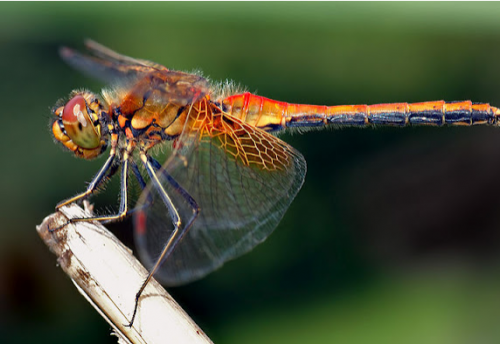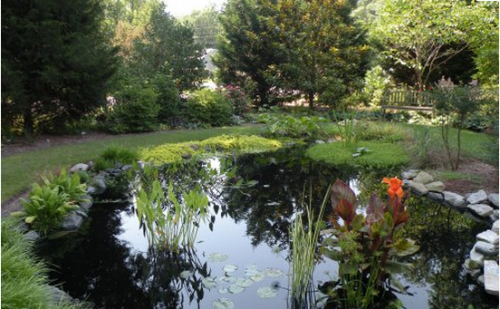Brooklyn’s beautiful summer days coax us outdoors to converse and lounge in our parks, backyards, and porches. In the heat of the summer, water features are a welcome cooling sight and draw the abundance of people looking to maximize their free time. However, these same water features are also home to pesky mosquitoes, diminishing the quality of our outdoor experiences.
At Eco Brooklyn, we are developing natural methods of mosquito control. These methods aim to diminish the mosquito’s presence while maintaining the balance of our fragile local ecosystems. We have a mosquito-repellant service with several components and options, which we make available to the community in an attempt to combat the mosquito problem on a larger scale.
Our service uses three main tools to reduce mosquitoes:
1. Landscaping Mosquito repellent plants – yards, pots and living walls.
2. Water features for mosquito predators – Fish and Dragonfly ponds.
3. Natural oils applied to the skin and garden area surfaces.
New York and Brooklyn were originally full of marshes, rivers and wetlands, which most probably had lots of mosquitoes. The difference now is that those areas are gone, and so are all the creatures and plants that kept mosquitoes at bay.
Now, with little left but clogged gutters and putrid waterways like the Gowanus Canal, there are few predators to the mosquito. Add to that the introduction of non-native mosquitoes from Asia that have even less predators here, and you have a real mosquito heaven (for the mosquito that is. Not for us humans).
Mosquitoes are a problem worldwide. A wide variety of defenses have been put into effect to reduce the impact of the insect, some with more success than others.
Many of these methods have negative affects on the surrounding environment and may in fact be simultaneously attacking the mosquito’s natural predators. Broad-spectrum insecticides such as the organic pesticide Pyrethrum may kill mosquitoes and other insect pests, but they also kill beneficial pest-controlling insects such as ladybugs and lacewings.
Any attempt to reduce mosquito numbers must be founded in the natural lifecycle of the mosquito itself. The mosquito lays its eggs in standing water and hatches as larva before changing into pupae, then emerging and taking flight. Any standing water greater than a bottle cap’s full can serve as a mosquito-breeding site.
As such it is very important to eliminate small containers that have the potential to fill with rainfall and remain inactive. The elimination of all rainwater collection sites, however, is far from necessary. Slightly larger ponds can be effective methods of mosquito control by acting as habitats for the mosquito’s natural predators.
Some of the mosquito’s natural predators are dragonflies, damselflies, bats, and numerous fish species. While bats do consume mosquitoes, they are at most 5% of their diet. Extensive bat preservation policies, while beneficial to the bat, may not in fact greatly diminish the inhabiting mosquito population. Many fish will consume mosquitoes, but some are better adapted to the task than others.
Fish
The highly touted mosquitofish Gambusia affinis can consume 42-167% of its body weight in mosquitoes per day. Its mouth is faced upwards towards the sky, allowing for more efficient consumption of mosquito larvae. It can tolerate various temperature changes in the water, salinity, decreased food supply, and organic pollutants and is compatible with goldfish, koi, and karp.
A nonnative species, it was first introduced to New York’s waters as a biological control for mosquitoes. However, mosquitofish were found to be ill-adapted to the cooler waters. Most importantly, it is not compatible with native species and very few instances of coexistence exist.
As such EcoBrooklyn does not recommend the introduction of mosquitofish into existing garden ponds. If your brownstone garden already includes a fish pond, we recommend finding a hardy native fish species that can reproduce in the local climate, such as the fathead minnow.
Dragonflies and Damselflies
Fish are not the only mosquito predator reliant on a pond source. Dragonflies and damselflies lay their eggs in foliage above or below the waterline of a pond. They then hatch as aquatic predators, consuming mosquito larva to feed and grow.
Depending on the species, this stage of life takes 1-2 months to 5 years. The larva then climb out of the pond via a plant stalk or rock and seek protection in nearby foliage before taking flight and attacking mosquito adults.
The life cycle of dragonflies and damselflies therefore shadows that of the mosquito, but the predator-prey relationship remains the same effectively controlling mosquito populations. Adult dragonflies and damselflies return to water features to feed and sun themselves, and eventually lay eggs in the pond.
Eco Brooklyn offers a dragonfly pond building service as a component of its mosquito solutions. Dragonfly ponds are a beautiful addition to a brownstone garden, and the insects provide welcome entertainment on a summer’s eve.
15% of North America’s 307 dragonfly species are in danger of extinction, and a new dragonfly habitat can help the graceful insects to reestablish themselves while also providing a welcome solution to the mosquito problem!
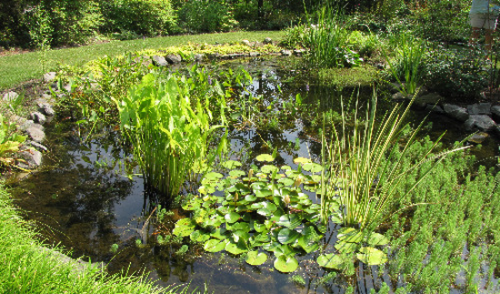
A dragonfly pond should vary in depth, with a segment around 2 ft in depth and flat rocks such as slate on the shallow side. Water plants should be included in the deeper parts of the pond to serve as nurseries, with perching sedges and rushes on the side for adults. It is also recommended that a small wildflower grassland be planted on the side of the pond.
The pond should include erect and submerged plants to allow for dragonflies and damselflies at all stages of the life cycle. A small pump can be included to keep the water clean and oxygenated, although this is not necessary for larger ponds. While the best dragonfly ponds are 20 feet wide, this width is not practical for a NY lot nor is it necessary to maintaining a healthy population.
In fact, adapted whiskey barrels, fountain basins, and earthen or plastic lined ponds can all provide welcome habitats as long as there are sloped sides and varying depths. The dragonfly larvae like to hide in the depths of the water to escape predation, but sufficient plant cover may substitute for that in the case of shallower ponds.
A simple stake in the pond can substitute for erect perching plants. It is very important that the pond be 70% in the sun and that no fish are added to the water.
Fish consume dragonfly larva as well as mosquito larva and are therefore incompatible, unless we design the pond to have two sections so there are safe places for the larvae to escape.
Once the pond is built we jumpstart it with a few spadefulls of soil from a nearby pond with a known dragonfly population.
The following plants work well in a dragonfly pond:
Deepwater -submerged plants
Curly pondweed – Potomogeton crispus
Water Starwort – Callitriche spp
Hornwort – Ceratophyllum demersum
Spiked Water Milfoil – Myrophyllum spicatum
Deeper water Floating Plants
Stiff-leaved Water Crowfoot – Rannunculus circinatus
Frogbit – Hydrocharis morus-ranae
Broad-leaved pondweed – Potomegetum natans
Amphibious Bistort – Polygonum amphibium
Yellow Waterlily – Nurphar lutea
Fringed Waterlily – Nymphoides pelatata
Shallow water emergent plants
Flowering Rush – Butomus umbellatus
Water Horsetail – Equisetum fluviatile
Bur-reed – Sparganium erectum
Water Plantain – Alisma plantago-aquatica
Common Spike Rush – Eleocharis palustris
Bog Bean – Menyanthes trifoliate
Plants
EcoBrooklyn also installs plants as a direct means of mosquito control. We offer several plant-based services:
-vertical frames planted with mosquito repellant plants, to be hung on the walls of porches, balconies, and other outdoor activity areas. The frames are made of cedar or pine as both of these woods repel mosquitoes.
-plant troughs filled with mosquito repellant plants, placed near outdoor activity areas
-herbal oil concoctions designed to specifically repel mosquitoes; these can be applied directly to the skin or sprayed on the surfaces of an outdoor activity area
-dried mosquito-repellant plants placed into sachets to be hung in desired locations
Below we have organized known mosquito repellant plants into two categories: native and nonnative species. Edible plants are subcategorized. We work with clients to offer aesthetically pleasing plant combinations.
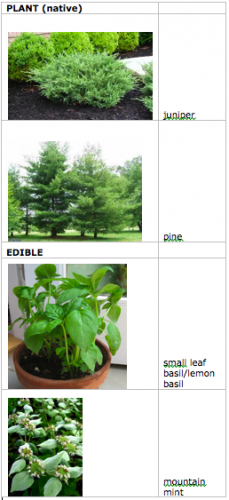
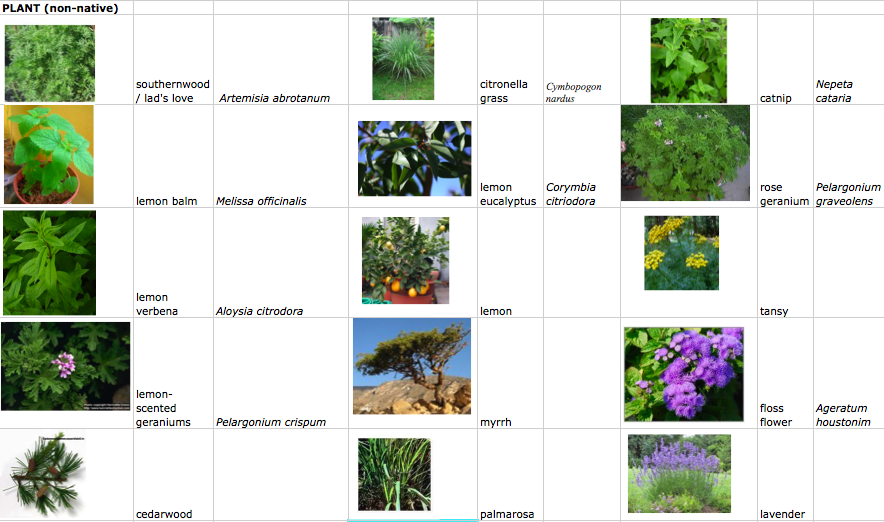

Once planted, it is advised that plants be brushed before engaging in outdoor activities in order to release some of the scent. The compounds citronellal, geraniol, geranial, and pulegone are all known to repel mosquitoes. Plants containing these compounds are the most effective.
It is important to note that the plants themselves will not repel mosquitoes, it is the oil within their leaves that acts as a repellent. This is why brushing the leaves (resulting in small breaks) helps to repel mosquitoes. Our plant troughs and vertical installations are meant to be a reliable supplier of leaves for your own herbal concoctions while also aesthetically ameliorating your home.
We highly recommend troughs consisting of edible mosquito repellent plants, which provide the additional ecosystem service of providing food.
Herbal solutions
While there are many variations of mosquito repellant liquids, they are made similarly.
The first method uses actual plant leaves from mosquito repellant plants. These are steeped in water, strained, and then the liquid is added to isopropyl alcohol. Any combination of plants works well as well as using a single plant per batch.
The second method involves mixing 2 ½ teaspoons of any combination of essential oils (basil, cedarwood, cinnamon, citronella, juniper, lemon, myrrh, palmarosa, pine, rose geranium, rosemary) with 1 cup of 190-proof grain alcohol. These concoctions can be applied directly to the skin or used in a spray bottle. If applied to the skin, it may take some experimentation to determine what combination of oils works best with one’s body chemistry.
As described by the above overview, there are many natural means of combating the mosquito problem in Brooklyn. EcoBrooklyn is constantly improving its services through experimentation in the Green Show House and offers its solutions to the community.
These solutions aim to repel mosquitoes, add to the aesthetic value of Brooklyn brownstones, and support native species and the local ecosystem.

